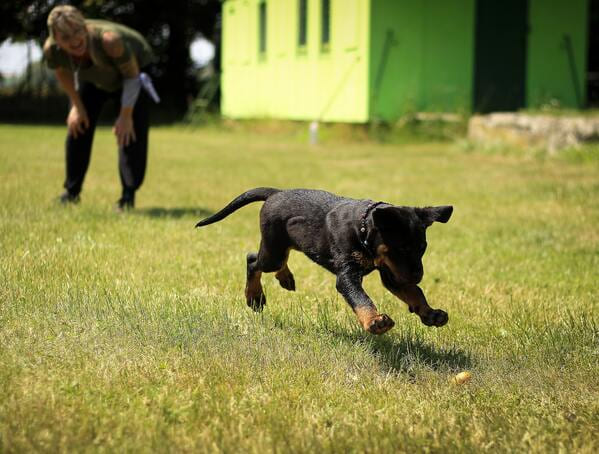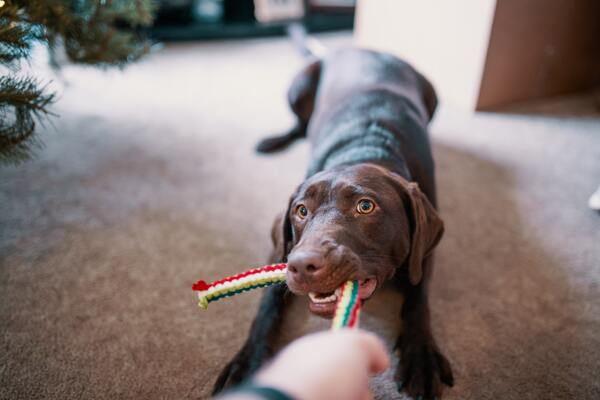

Playing With Your Dog: An Owner’s Guide
Owning a dog is hard work, but it’s plenty of fun too. Read through our guide on bonding with pets through games.

Writer Animalia Team
9 min read

You’ve probably read about all the hard work and responsibility that goes into keeping a growing pup happy and healthy. You’ve checked all the essentials off your list, built a strong relationship with your vet, and conducted thorough research to ensure you’re prepared for the job ahead.
But what about all the fun? Fortunately, you’ll enjoy plenty of opportunities to play with your dog throughout their life. In fact, fun and games are an important part of strengthening your bond. It’s also a great way to reinforce training, keep dogs from growing bored, and provide necessary exercise. The types and frequency of your games will likely depend on your dog’s breed, age, health, and personality.
The benefits of playing with your dog
Provides exercise
Play is great exercise for both you and your dog. It releases pent-up energy and helps stave off obesity and the related health concerns. To gain the benefits of exercise, schedule two to three play sessions per day.
Helps the bonding process
A quality play session strengthens the emotional bond between you and your pet, making for years of mutual affection and respect.
Reinforces training
Play sessions are a fun way to reinforce desirable behaviors. Use games as an opportunity to deploy common commands like “sit,” “stay,” “drop,” and “let go.”
Discourages problem behaviors
Playing with dogs provides a suitable outlet for excess energy, potentially discouraging them from boredom and the repetitive, sometimes destructive, behaviors it can cause.
Delivers mental stimulation
Most games provide your dog with mental stimulation in addition to exercise. Daily play sessions are a great way to keep your dog’s natural playfulness and sense of curiosity alive as they mature throughout their life.
Prevents anxiety
Short daily play sessions are great mood boosters for both you and your pet. Some dog owners even report that playtime with pets helps alleviate some depression symptoms.
Improves their social life (and yours)
Play games in the dog park and the chances are good that another dog will join in. While your dogs get to know each other, take time to strike up a conversation with your new canine acquaintance’s owner. A recent study shows that chatting with other pet owners is one of the most common and effective ways to meet new people. Set up puppy play dates with your new pals and consider enrolling in agility or obedience classes to meet another new group of pets and owners.
Tips for keeping playtime safe
- Make sure toys are safe for your dog. They should be soft enough to avoid injuries to the teeth and durable enough to avoid breaking into pieces and posing choking risks.
- Vary your dog’s selection of toys to keep them engaged and excited. Try out new colors, textures, and patterns to see what they like best.
- Teach your dog the “leave” command to signal the end of a game.
- Hold toys around or below waist level to discourage your dog from jumping.
- Use an excited voice when playing and offer plenty of praise for positive behaviors, but be ready to put unwanted behavior like aggressive play to a stop.
- Let your dog win games to keep them engaged and stop them from growing discouraged.
- Don’t play rough games, tease your dog, or let them chase children. These activities can get out of hand fast.
- Don’t force your dog to play or engage with other dogs if they don’t want to. While exercise and socialization are important for a happy dog’s development, forcing the issue can lead them to associate trips to the dog park with negative feelings.
Your dog is not into playing? Here are some tips to follow

To most dogs, especially puppies, play comes naturally. Some dogs, however, like adult rescues may require a little more convincing. It’s possible they’ve never enjoyed the company of loving people, canine companions, or even toys. Follow these simple tips for getting them more comfortable with play sessions:
- Start with solo playtime before introducing additional dogs.
- Get down on your dog’s level, joining them on the floor for the start of games.
- Instead of pushing toys toward your dog, try this method: drop a toy, pull it away, and cradle it gently. Your dog will gradually become intrigued and join in, providing an opportunity for a quick and exciting game of tug-of-war.
- Puzzle toys are a great way to keep dogs engaged over long periods and familiarize them with solitary play.
6 games to play with your dog
There’s only one way to figure out the types of games your dog enjoys – by getting out there and experimenting. Here are six ideas for getting started.
Hide and seek
Your dog may love using their amazing sense of smell as they seek out hidden people, toys, or treats. Command your dog to “sit” and then hide behind a door or sofa before calling them to find you. As they get more confident, hide in different rooms or even outside. To play with food or toys, first let your dog sniff treats or objects before hiding them. After a few successful retrievals, try hiding toys and treats without showing them to your dog beforehand. Don’t put them in your favorite flower bed or in places that may be dangerous for your dog. Food dispensing toys offer the best of both worlds as a goal.
Pounce and shake
Use loud squeaking toys for this game. Throw toys in the air and encourage your dog to either jump in the air for them or pounce once they’ve hit the ground. Make sure your dog has learned the “leave it” command or they may wind up going through tons of toys. Many dogs will play this game on their own once they’ve got the hang of it.
Chasing bubbles
Many dogs love chasing bubbles, jumping and running in pursuit is excellent exercise. At first, just blow one or two, point to them, and say “catch.” You’ll roll around with laughter as your dog chases after them. Always use non-toxic bubble mixes designed for children and make sure to wipe your dog’s face and eyes when the game is over.
Tug-of-war

Most dogs love tug-of-war and will even instigate games themselves. Play with rubber rings, squeaky toys, or durable rope toys. If it’s your first time playing tug-of-war, instruct your dog to “take it” as you move the toy towards them. Once you’re both holding the toy, shake it from side to side and up and down. Every so often, stop the game by saying “leave,” putting your hands by your side, and staying silent. When your dog releases the toy, reward them with praise or a treat, and start playing again. If your dog gets over-excited, jumps up, or grabs your clothing, immediately stand still and go quiet. Aggressive negative reinforcement could have unintended consequences. When you’ve decided the game is over, put the toy out of sight.
Chase and retrieve
Use balls, Kongs on ropes, or frisbees for this popular activity. Make sure any toys you choose have no sharp edges and that they’re not small enough to swallow. Never play “fetch” with a stick. A dog with a stick is a classic image, but catching sticks by a sharp end could injure your dog’s mouth or throat. Throw horizontally rather than vertically to avoid awkward landings and potential injuries. Remember: most dogs happily chase after something when it’s thrown, but not every dog will instinctively bring their bounty back. Teach them to do this by showing them the toy on the floor and letting them pick it up. Reward them with a treat after they “drop” it near you. Then, walk or run backward when your dog picks up the toy and encourage them to bring it to you. Next, throw the toy while you hold your dog and release them once the toy has landed on the floor. Repeat this process regularly until your dog has got the hang of it. If you want your dog to get even more exercise, frisbees travel a long way and make a great choice!
Agility courses
You don’t need to sign up for classes or purchase expensive equipment to try out agility training with your dog. Get creative with items in your home or yard and design an agility course of your own. These will mentally stimulate your dog and teach them new tricks, especially if you change up the course regularly. The combination of physical and mental stimulation will make for an exciting time and leave dogs ready for naps. If you sign them up for classes, your dog will learn to interact with other dogs while simultaneously getting plenty of exercise and mental stimulation.
Sign up for pet insurance and play with confidence
Nobody wants to believe that fun games with their dog can take a turn for the worse, but accidents and injuries happen every day. While a pet insurance policy can’t stop mishaps from occurring and keep your dog in perfect health, it can dramatically reduce the stress of addressing health concerns of all sizes. Get a quote today and enjoy years of confident, fearless play with your dog.





We offer the most
comprehensive coverage
out there
car with a spare tire for life’s bumps.
Having Animalia is like a pimped-out
Rolls Royce with a swimming pool
in the trunk.



Get your pet insurance quote
Pet type
- Dog
- Cat
What is your pet's name?
Zip code





